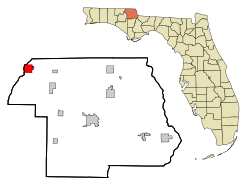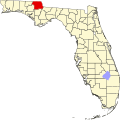Graceville, Florida
 From Wikipedia - Reading time: 9 min
From Wikipedia - Reading time: 9 min
Graceville, Florida | |
|---|---|
| City of Graceville | |
 "Welcome to Graceville" sign located on SR 77 | |
| Motto: "Where The Living Is Easy" | |
 | |
| Coordinates: 30°57′33″N 85°30′48″W / 30.95917°N 85.51333°W | |
| Country | |
| State | |
| County | Jackson |
| Incorporated | 1902[1] |
| Government | |
| • Type | Commission–Manager |
| • Mayor | Arthur PW Obar, Jr. |
| • Mayor Pro Tem | Walter Olds |
| • Commissioners | Curtis Pinkard, Marshall Davis, and John McClendon |
| • City Manager | Michelle Watkins |
| • City Clerk | Misty Smith |
| Area | |
• Total | 4.44 sq mi (11.49 km2) |
| • Land | 4.33 sq mi (11.21 km2) |
| • Water | 0.11 sq mi (0.28 km2) |
| Elevation | 151 ft (46 m) |
| Population (2020) | |
• Total | 2,153 |
| • Density | 497.46/sq mi (192.05/km2) |
| Time zone | UTC-6 (Central (CST)) |
| • Summer (DST) | UTC-5 (CDT) |
| ZIP code | 32440 |
| Area code | 850 |
| FIPS code | 12-27000[3] |
| GNIS feature ID | 0283260[4] |
| Website | www |
Graceville is a city in Jackson County, Florida, United States. It is near the Alabama state line. The population was 2,153 at the 2020 census.
Geography
[edit]The approximate coordinates for the City of Graceville is located at 30°57′33″N 85°30′48″W / 30.95917°N 85.51333°W (30.959044, −85.513280).[5]
Florida State Road 2 and Florida State Road 77 are the two main highways through the city. FL SR 2 runs from west to east through the center of town, leading east 7 mi (11 km) to Campbellton and west 10 mi (16 km) to Esto. FL SR 77 runs from south to north through the center of town, leading northeast 22 mi (35 km) to Dothan, Alabama via a connection with Alabama State Route 109, and south 12 mi (19 km) to Chipley.
Jackson County is a rural community primarily composed of business in agriculture, manufacturing, service, and retail trade. In addition, many government facilities are located within the county, including a federal prison and three state correctional institutions. Elevation ranges from 50 to 330 feet (100 m) above sea level. Marianna is 185 feet (56 m) above sea level.
Soil composition ranges from sandy to clay base. The most typical soil is sandy loam. Jackson County has a vast deposit of nearly pure limestone. The county abounds in lakes including Lake Seminole, Compass Lake, Merritt's Mill Pond and Ocheessee Pond. The Chattahoochee River-Apalachicola River, which is navigable and has a nine-foot channel depth, forms the county's eastern border. The Chipola River flows south through the center of the county.
Climate
[edit]The climate in this area is characterized by hot, humid summers and generally mild winters. According to the Köppen climate classification, the City of Graceville has a humid subtropical climate zone (Cfa).
- Land area: 916 sq mi (2,370 km2).
- Region of the country: Southeast
- Average temperature: 67.2 °F
- Average high temperature: 79.0 °F
- Average low temperature: 55.0 °F
- Annual rain: 66.0 inches
- Annual snowfall: 0.0 inches
- Earthquake index: 0.0
Demographics
[edit]| Census | Pop. | Note | %± |
|---|---|---|---|
| 1910 | 734 | — | |
| 1920 | 840 | 14.4% | |
| 1930 | 1,012 | 20.5% | |
| 1940 | 1,181 | 16.7% | |
| 1950 | 1,638 | 38.7% | |
| 1960 | 2,307 | 40.8% | |
| 1970 | 2,560 | 11.0% | |
| 1980 | 2,918 | 14.0% | |
| 1990 | 2,675 | −8.3% | |
| 2000 | 2,402 | −10.2% | |
| 2010 | 2,278 | −5.2% | |
| 2020 | 2,153 | −5.5% | |
| U.S. Decennial Census[6] | |||
2010 and 2020 census
[edit]| Race | Pop 2010[7] | Pop 2020[8] | % 2010 | % 2020 |
|---|---|---|---|---|
| White (NH) | 1,572 | 1,370 | 69.01% | 63.63% |
| Black or African American (NH) | 551 | 582 | 24.19% | 27.03% |
| Native American or Alaska Native (NH) | 7 | 7 | 0.31% | 0.33% |
| Asian (NH) | 4 | 9 | 0.18% | 0.42% |
| Pacific Islander or Native Hawaiian (NH) | 3 | 0 | 0.13% | 0.00% |
| Some other race (NH) | 0 | 9 | 0.00% | 0.42% |
| Two or more races/Multiracial (NH) | 46 | 85 | 2.02% | 3.95% |
| Hispanic or Latino (any race) | 95 | 91 | 4.17% | 4.23% |
| Total | 2,278 | 2,153 |
As of the 2020 United States census, there were 2,153 people, 814 households, and 451 families residing in the city.[9]
As of the 2010 United States census, there were 2,278 people, 1,012 households, and 530 families residing in the city.[10]
2000 census
[edit]As of the census[3] of 2000, there were 2,402 people, 933 households, and 572 families residing in the city. The population density was 559.0 inhabitants per square mile (215.8/km2). There were 1,076 housing units at an average density of 250.4 per square mile (96.7/km2). The racial makeup of the city was 73.48% White, 23.90% African American, 0.92% Native American, 0.17% Asian, 0.25% from other races, and 1.29% from two or more races. Hispanic or Latino of any race were 1.46% of the population.
In 2000, there were 933 households, out of which 26.8% had children under the age of 18 living with them, 44.3% were married couples living together, 13.8% had a female householder with no husband present, and 38.6% were non-families. 33.9% of all households were made up of individuals, and 17.3% had someone living alone who was 65 years of age or older. The average household size was 2.35 and the average family size was 3.08.
In 2000, in the city, the population was spread out, with 23.4% under the age of 18, 13.3% from 18 to 24, 23.1% from 25 to 44, 19.7% from 45 to 64, and 20.6% who were 65 years of age or older. The median age was 37 years. For every 100 females, there were 84.3 males. For every 100 females age 18 and over, there were 80.0 males.
In 2000, the median income for a household in the city was $23,031, and the median income for a family was $32,778. Males had a median income of $25,969 versus $20,109 for females. The per capita income for the city was $14,245. About 15.1% of families and 20.7% of the population were below the poverty line, including 25.0% of those under age 18 and 18.9% of those age 65 or over.
Education
[edit]The Jackson County School Board operates all public schools.
- Graceville Elementary School
- Graceville High School
- Poplar Springs High School
- Baptist University of Florida
Notable people
[edit]- Neal Anderson, former professional NFL football player
- John Wayne Mixson, former Lieutenant Governor of Florida, and former Governor of Florida
- Ricky Polston, Chief Justice of the Florida Supreme Court
- Bob Snyder, musician
- Colston Weatherington, former professional NFL football player
Transportation
[edit]Graceville was served by the Louisville and Nashville Railroad at the end of the stub Georgiana Branch which reached the town on July 16, 1902,[11] and, later, by the Seaboard System from 1983, and then by the Alabama and Florida Railroad, when the line was spun off as a shortline. The line was freight-only, the last L&N passenger local having come off circa late 1950. Train 27 departed Georgiana, Alabama, at 7:15 a.m., arriving at Graceville at 10:40 a.m. Returning train 28 departed Graceville at 11:05 a.m. and arrived at Georgiana at 2:35 p.m. Following World War II, with the improvement of local roads and the availability of private vehicles, the railroad petitioned the Alabama Public Service Commission to discontinue daily except Sunday trains between Georgiana and Graceville on November 6, 1947. "Passenger travel on trains 27 and 28 is now, and has been for several years, at a very low ebb, there being times when the train crew exceeds the number of passengers on the train," explained the railroad company in court documents dated October 31, 1950, appealing the commission's refusal to allow discontinuance. The operating deficit averaged ~$188 per day.[12]
The A&F abandoned the line between Geneva and Graceville on January 16, 1984.[13] The Atlanta and St. Andrews Bay Railroad also built a seven-mile connection into town from the east from their Dothan-Panama City mainline at Campbellton, completed July 14, 1971,[14] but this, too, was abandoned by 1996 after the possible bridge traffic from the A&F disappeared. The "Bay Line" would buy the small yard and wye in town from the A&F. Only a few rails embedded in former town grade crossings mark the abandoned right of ways.
References
[edit]- ^ "FLORIDA CITIES BY INCORPORATION YEAR" (PDF). Florida League of Cities.
- ^ "2020 U.S. Gazetteer Files". United States Census Bureau. Retrieved October 31, 2021.
- ^ a b "U.S. Census website". United States Census Bureau. Retrieved January 31, 2008.
- ^ "US Board on Geographic Names". United States Geological Survey. October 25, 2007. Retrieved January 31, 2008.
- ^ "US Gazetteer files: 2010, 2000, and 1990". United States Census Bureau. February 12, 2011. Retrieved April 23, 2011.
- ^ "Census of Population and Housing". Census.gov. Retrieved June 4, 2015.
- ^ "P2 HISPANIC OR LATINO, AND NOT HISPANIC OR LATINO BY RACE - 2010: DEC Redistricting Data (PL 94-171) - Graceville city, Florida". United States Census Bureau.
- ^ "P2 HISPANIC OR LATINO, AND NOT HISPANIC OR LATINO BY RACE - 2020: DEC Redistricting Data (PL 94-171) - Graceville city, Florida". United States Census Bureau.
- ^ "S1101 HOUSEHOLDS AND FAMILIES - 2020: Graceville city, Florida". United States Census Bureau.
- ^ "S1101 HOUSEHOLDS AND FAMILIES - 2010: Graceville city, Florida". United States Census Bureau.
- ^ Herr, Kincaid A., "The Louisville & Nashville Railroad 1850-1963", The University Press of Kentucky, 2000, ppbk. ed. 2009, ISBN 978-0-8131-9318-2, page 141.
- ^ Court document 93 F. Supp. 544 (1950), Louisville & N. R. Co. v. Alabama Public Service Commission et al. Civ. No. 698, United States District Court, M. D. Alabama, N. D., October 31, 1950.
- ^ "Alabama Rail Plan 2008" (PDF). December 2008. pp. Table 4-1. Archived from the original (PDF) on August 14, 2011. Retrieved September 10, 2010.
- ^ Lewis, Edward A. (1986). American Shortline Railway Guide (3rd ed.). Kalmbach Publishing Company. pp. 25. ISBN 0890240736.
 KSF
KSF